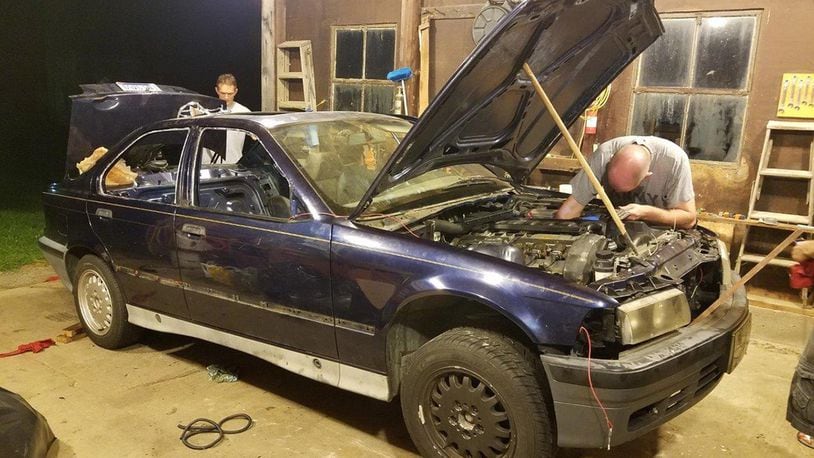The idea of participating in the race materialized approximately three years ago when a few of the engineers discussed it after seeing it featured on television and online. Structural Materials Evaluation team lead Jeff Calcaterra gradually recruited colleagues Nick Jacobs, Mike Hirsch, and Ken LaCivita, along with supporting team members Dave Roberts and Brett Jordan. When they secured a suitable garage workspace earlier this year, the team was ready to get started.
“In that time we found a 1992 BMW 325 with no title and its engine bay in pieces for $400,” said Calcaterra. “We towed it to the garage and started working on it.”
The automotive reclamation project was a daunting one. Calcaterra said that when the team picked up the car, it was far from operable. In fact, many of its parts were scattered on the garage floor. They literally swept up the spare parts and set about the task of figuring out what they were, if they were needed and how to install them.
He explained that the process was similar to one he and his team members encounter every day as materials integrity engineers.
“In our professional life, we have to figure out how mechanical or electrical systems work all the time. We have to figure out why they break and what the weak points are. So when given a box of parts to put together into something that’s supposed to run, we’re using all the same skills. It was a very practical application of what we do for the Air Force on a daily basis,” Calcaterra said.
The team put those skills to good use as they engaged in a major troubleshooting effort to bring the engine back to operating condition. Additionally, they added safety equipment including a roll cage, race seat, six-point harness, and kill switch. Because race rules place no limits on the cost of safety equipment, the team was free to purchase and install this equipment, as well as wheels and tires, with no financial restrictions.
Meeting once a week after work, the team tirelessly pieced together the car, carefully keeping an eye on the cost. If there was a part that could be removed and sold, the team did so in an effort to keep under the $500 threshold.
After four months and a fresh coat of paint, the once bedraggled automobile took on a new life and was ready to race. The next step was hitting the track.
For the team’s inaugural race, they headed to South Haven, Michigan, Oct. 14-15, for the 24 Hours of LeMons race at Gingerman Raceway. Upon arrival, Calcaterra said it became apparent that the competition was fierce, prepared and ready to race. The biggest obstacle, however, was the weather.
“At about 3 o’clock that first morning, the rain started, and it rained for the rest of the weekend,” said Calcaterra. “It was nonstop. I believe we had between two to three inches of rain on Saturday with wind gusts up to 40 miles per hour.”
The team slept in the car trailer and awoke the next morning when the wind blew open the trailer door, collapsing the portable canopy.
Not only did the rain make the pit area wet and miserable, the soggy track presented a challenge in terms of maneuverability. Teams are allowed a maximum of four black flag time penalties per day, each increasingly steep until the fourth flag, which disqualifies a team for the day. Calcaterra said that as the team’s designated first driver, he also received the first black flag after only eight laps due to spinning off the wet track.
The first day, the team received a total of three black flags, mostly for going off the track. On day two, however, things literally started to look brighter. With a drier track and a better feel for the layout, the team was able to achieve faster speeds and fewer track violations. In fact, the team racked up more than 200 laps before ending the day to begin the journey home.
When asked if he considers the race a success, Calcaterra responds, “Absolutely!”
He said his main goal for this initial attempt was simply getting the car completed and ready to race. Ending the event with no major mechanical problems was icing on the cake. Overall, the team came in tied for 62nd place out of 93 competitors, which was very encouraging to the team of rookie drivers.
Next year’s team goals are loftier. Calcaterra said now that the team has a better understanding of the race and the competitors, they will make a few more tweaks to the car and devise a new driving strategy, focusing on fewer time-consuming pit stops and driver changes. The team has no intentions of stopping any time soon, and has already begun minor repairs and planning sessions. Initial plans include racing again at the South Haven 24 Hours of LeMons event, as well as one in Joliet, Illinois. The team also plans to visit local tracks to hone their driving skills.
“This could grow out of control very quickly,” Calcaterra said, noting that the temptation is great to invest a lot of personal time and effort into the project. Nonetheless, he and the team are going ahead full-throttle, and having a great time while team-building and putting their technical skills toward a unique application.
“This is ‘kid-at-Christmas’ fun. It is a blast!”
About the Author
